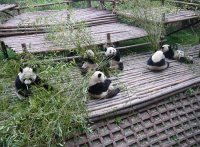一、What is Cat Poop Coffee?
If you're a coffee lover, you've probably heard of various types of exotic and unique coffee beans. One such coffee that has gained attention in recent years is known as "Cat Poop Coffee". Though it may sound unappealing, this coffee, officially called Kopi Luwak, is highly sought after by coffee connoisseurs around the world.
What is Cat Poop Coffee?
Cat Poop Coffee refers to coffee beans that have been digested and excreted by a specific type of small Asian mammal called the Asian palm civet. The civet eats the coffee cherries but is unable to digest the beans, which are then passed through its digestive system. The beans are collected from the animal's feces, thoroughly cleaned, and then roasted to create a unique and highly aromatic coffee.
The Origins of Cat Poop Coffee
Kopi Luwak, or Cat Poop Coffee, originates from Indonesia, where it was first discovered by Dutch colonialists during the 18th century. The civet was naturally drawn to the coffee trees, eating the ripest cherries and leaving the undigested beans behind. The locals began to collect these beans, noticing their special flavor when brewed.
Why is Cat Poop Coffee So Expensive?
One of the reasons Cat Poop Coffee is so expensive is due to its limited supply. The production process is labor-intensive, as the beans must be meticulously collected from the civet's feces. Additionally, the civets are highly selective in the cherries they consume, usually opting for the best and ripest ones. This selection process also contributes to the high cost of these coffee beans.
The Flavor Profile of Cat Poop Coffee
Cat Poop Coffee is known for its unique and distinct flavor profile. The digestive enzymes of the civet cat impart a smoothness and earthiness to the coffee. Some describe it as having a syrup-like body with hints of chocolate and caramel. It is generally regarded as a delicacy among coffee enthusiasts.
Ethical Concerns and Sustainability
Over the years, there have been ethical concerns surrounding the production of Cat Poop Coffee. Originally, the coffee was harvested from wild civets, but due to its increasing popularity, some producers have resorted to capturing and confining civets in small cages. This practice has raised concerns about animal welfare and sustainability.
In Conclusion
Cat Poop Coffee, or Kopi Luwak, is a unique and highly sought-after coffee known for its distinctive flavor. While it may not be for everyone, it has garnered a dedicated following among coffee enthusiasts. However, it is important to be mindful of the ethical considerations surrounding its production.
Thank you for reading this article! We hope you found it informative and interesting. If you ever have the opportunity to try Cat Poop Coffee, it could certainly be a memorable and adventurous coffee experience.
二、The Fascinating World of Cat Poop Coffee
When it comes to unique and exotic coffee experiences, there is one that stands out from the rest – Cat Poop Coffee. Also known as Kopi Luwak, this special type of coffee is made from the droppings of the Asian palm civet, a small cat-like animal native to Southeast Asia.
While it may sound bizarre, Cat Poop Coffee has gained worldwide popularity for its distinct flavor and the fascinating process behind its production. The journey of this coffee starts with the palm civet consuming coffee cherries. The cherries go through a natural fermentation process in the civet's digestive system, and the beans are then excreted.
After being collected from the civet's feces, the coffee beans are thoroughly cleaned and roasted to perfection. The natural fermentation the beans undergo while inside the civet's digestive system is believed to give Cat Poop Coffee a unique taste profile characterized by low acidity and a smooth, full-bodied flavor.
Despite its unusual origins, Cat Poop Coffee has become a highly sought-after delicacy among coffee connoisseurs. The rarity and limited production of this coffee contribute to its high price tag, with some varieties fetching hundreds of dollars per pound.
However, it is essential to consider the ethical concerns surrounding Cat Poop Coffee. The growing demand has led to the exploitation of civets, with many operations confining the animals in cages and force-feeding them coffee cherries. As a result, there has been a rise in ethical and sustainable alternatives such as wild-sourced and ethically farmed Cat Poop Coffee.
The Science behind the Flavor
To truly appreciate the flavor of Cat Poop Coffee, it is important to understand the science behind it. The enzymes present in the civet's digestive system break down proteins in the coffee beans, resulting in less bitterness. Additionally, the enzymes enhance the coffee's natural sweetness, leading to a more nuanced and delicate flavor profile.
Is Cat Poop Coffee Worth the Hype?
The taste of Cat Poop Coffee is undoubtedly unique, but whether it is worth the hype is a subjective matter. Some coffee enthusiasts enjoy the smooth and rich flavor, while others do not find it significantly different from regular coffee. Ultimately, it comes down to personal preference and the willingness to explore unusual and adventurous coffee experiences.
In conclusion, Cat Poop Coffee, despite its unusual origins, has captured the attention of coffee lovers worldwide. The distinct flavor profile and the captivating story behind its production make it a fascinating and intriguing choice for the adventurous coffee connoisseur. However, it is crucial to prioritize ethical considerations and opt for sustainable and responsible sources of Cat Poop Coffee.
Thank you for taking the time to explore the world of Cat Poop Coffee. We hope this article has provided you with valuable insights into this unique and controversial coffee experience.
三、What is Cat Poop Coffee? A Guide to the World of Civet Coffee
Have you ever heard of cat poop coffee? Also known as civet coffee, this unique and expensive beverage has been gaining popularity among coffee enthusiasts around the world. In this article, we will uncover the secrets behind cat poop coffee and explore its origins, production process, and taste. So, grab a cup of your favorite coffee and let's dive into the fascinating world of civet coffee!
What is Cat Poop Coffee?
Cat poop coffee, or civet coffee, is a type of coffee made from the beans that have been digested and excreted by the Asian palm civet, a small nocturnal mammal. The civet eats the ripe coffee cherries and the enzymes in its digestive system modify the beans, resulting in a unique flavor profile.
The Origins of Cat Poop Coffee
Cat poop coffee has a long history and can be traced back to the early 18th century in Indonesia. The Dutch colonialists introduced coffee plantations to Indonesia, and the locals discovered that the civets were attracted to the coffee cherries. They started collecting the civet's feces, extracting the partially-digested coffee beans, and processing them into a beverage.
The Production Process
The production of cat poop coffee is a combination of natural and human processes. After the civets consume the coffee cherries, the farmers collect the droppings from the wild civets or cultivate their own civet farms. The beans are then thoroughly washed and sun-dried to remove any impurities. Finally, the beans are roasted, ground, and brewed like any other coffee.
The Taste and Controversies
The unique production process gives cat poop coffee a distinct flavor profile. It is often described as smooth, rich, and less acidic than regular coffee. Some coffee connoisseurs claim that the civet's digestive enzymes enhance the flavor characteristics of the beans. However, the taste can vary depending on factors such as the civet's diet and the roasting process.
While cat poop coffee has gained a following among coffee enthusiasts, it has also faced controversies. Animal welfare advocates argue that the traditional method of harvesting civet coffee involves the capture, caging, and force-feeding of wild civets. However, there are ethical producers who prioritize the well-being of the civets and allow them to roam freely and choose their food.
Conclusion
Cat poop coffee, or civet coffee, is a unique and intriguing beverage that has captured the attention of coffee lovers worldwide. Its origins, production process, and taste make it a topic of fascination and debate. Whether you're adventurous enough to give it a try or prefer sticking to your usual cup of joe, learning about cat poop coffee provides a deeper appreciation for the diverse world of coffee.
Thank you for reading this article and exploring the world of cat poop coffee with us. We hope this guide has provided you with valuable insights into this extraordinary beverage.
四、The English Name for Cat Poop Coffee
Coffee connoisseurs around the world have been buzzing about a unique and rare gourmet coffee known as "cat poop coffee". But what is the English name for this intriguing brew?
The fascinating coffee in question is none other than "Kopi Luwak". Originating from Indonesia, Kopi Luwak is made from coffee beans that have been digested and excreted by the Asian palm civet, a cat-like mammal. The beans are collected from the civet's droppings, cleaned, roasted, and brewed, resulting in a coffee with a distinctive and sought-after flavor profile.
Although the name "cat poop coffee" has become a popular term for Kopi Luwak, it is not the official English name. The English translation for this unique coffee is "Civet Coffee". The word "civet" refers to the animal responsible for the coffee beans' unique journey through its digestive system.
So why all the fuss about Civet Coffee? The secret lies in the civet's selective feeding habits. The animal chooses only the ripest and most flavorful coffee cherries, and during the digestion process, enzymes in its stomach give the beans a natural fermentation. This fermentation is believed to enhance the coffee's aroma and reduce its bitterness, resulting in a smooth and luxurious cup of coffee.
The Controversy Surrounding Civet Coffee
Despite its allure, Civet Coffee has also faced its fair share of controversy. Concerns have been raised regarding the treatment and living conditions of the civets involved in the coffee production process. There have been reports of civets being kept in captivity and force-fed coffee cherries, leading to animal welfare concerns.
Fortunately, there are ethical and sustainable sources of Civet Coffee available. These responsible producers allow civets to roam freely in their natural habitat, where they can selectively feed on coffee cherries. This ensures that the coffee is produced in a more ethical and humane manner.
How to Enjoy Civet Coffee
If you're curious about trying Civet Coffee, be prepared for a unique and indulgent experience. Due to its rarity and intricate production process, Civet Coffee is considered one of the world's most expensive coffees.
To fully appreciate its flavors, it is recommended to brew Civet Coffee using methods that highlight its nuances. French press and pour-over brewing techniques are commonly recommended, allowing the rich aromas and flavors to shine through.
Despite the controversies surrounding Civet Coffee, its popularity continues to rise. Whether you're an adventurous coffee enthusiast or simply intrigued by its unconventional origins, trying a cup of Civet Coffee can be an extraordinary gastronomic adventure.
Thank you for taking the time to explore the English name for cat poop coffee, or as it is officially known, Civet Coffee. We hope this article has provided valuable insights and piqued your curiosity about this unique coffee.
五、What is Cat Poop Coffee? A Guide to This Unique Coffee Variety
Introduction
In recent years, there has been a growing trend in the coffee world that has captured the curiosity of coffee enthusiasts and connoisseurs alike - cat poop coffee. Also known as civet coffee or Kopi Luwak, this unique coffee variety has gained popularity for its distinct flavor and unusual production process. In this article, we will explore what cat poop coffee is, how it is made, and the reasons behind its high price tag.
What is Cat Poop Coffee?
Cat poop coffee refers to a type of coffee made from coffee beans that have been eaten and excreted by civet cats. These small mammals native to Southeast Asia consume ripe coffee cherries, but they are unable to digest the coffee beans inside. The beans then pass through their digestive system, undergoing fermentation and enzymatic changes that contribute to the unique flavors found in cat poop coffee.
The Production Process
The production of cat poop coffee involves several steps. First, civet cats are either kept in captivity or allowed to roam freely in coffee plantations. They selectively eat the ripest and highest quality coffee cherries. The consumed cherries go through the cat's digestive system, where enzymes in their stomachs break down proteins and alter the chemical composition of the beans.
After the beans are excreted in the cat's feces, they are collected, thoroughly washed, and then sun-dried. It is important to mention that reputable producers ensure ethical practices and prioritized animal welfare during the production process.
The Flavor Profile
Cat poop coffee is highly praised for its unique flavor profile. The fermentation and enzymatic changes that occur during the digestion process of the coffee beans result in a coffee with lower acidity and bitterness compared to traditional coffees. The flavor is often described as smooth, earthy, and rich, with hints of chocolate and caramel.
The High Price Tag
Cat poop coffee is known for its hefty price tag, often being one of the most expensive coffees in the world. There are a few reasons behind this. Firstly, the production process is labor-intensive and time-consuming. Civet cats are selective in their choice of coffee cherries, and the beans need to be carefully collected from their feces.
Additionally, the supply of cat poop coffee is limited. Civet cats can only produce a certain amount of beans, and the demand for this unique coffee is high. All these factors contribute to the high cost associated with cat poop coffee.
Conclusion
Cat poop coffee, also known as civet coffee or Kopi Luwak, offers an intriguing and distinctive coffee experience. While its production process may seem unusual, the resulting flavor profile has captured the attention of coffee enthusiasts worldwide. Whether you are adventurous enough to try this unique variety or simply curious about the world of coffee, cat poop coffee is certainly an interesting topic to explore.
Thank you for reading this article on cat poop coffee. We hope it has provided you with valuable insights into this fascinating coffee variety. If you are interested in expanding your coffee knowledge or exploring other coffee-related topics, feel free to check out our other articles. Happy brewing!
六、How to Say "Cat Poop Coffee" in English
Introduction
Cat poop coffee, known as "Kopi Luwak" in Indonesian, is one of the rarest and most expensive coffees in the world. It is made from coffee beans that have been partially digested and excreted by the Asian palm civet, a small mammal native to Southeast Asia. Despite its unorthodox production process, Kopi Luwak is highly regarded for its unique flavor, which is often described as smooth, earthy, and less bitter compared to regular coffee. If you need to talk about this interesting coffee in English, here are a few phrases to help you get started.
1. Cat Poop Coffee
The simplest and most straightforward way to refer to this coffee in English is "cat poop coffee." Although the term may sound a bit crude, it is widely recognized and understood.
2. Kopi Luwak
If you prefer using the original Indonesian term, you can say "Kopi Luwak" when speaking in English. It is a loanword commonly used among coffee enthusiasts and those familiar with specialty coffees.
3. Civet Coffee
Another way to refer to cat poop coffee is "civet coffee." This term emphasizes the involvement of the Asian palm civet in the coffee-making process. It is a more formal and scientific way to talk about this unique beverage.
Conclusion
While cat poop coffee may have an unconventional name, it has gained significant popularity among coffee connoisseurs around the world. Whether you choose to call it "cat poop coffee," "Kopi Luwak," or "civet coffee," these phrases will help you communicate about this fascinating and rare brew. So go ahead, indulge in a cup of this distinctive drink, and impress your friends with your knowledge of how to discuss it in English.
七、What is the English Name for Cat Poop Coffee?
The Fascinating World of Cat Poop Coffee
Cat poop coffee, also known as civet coffee, is a rare and highly sought after specialty coffee made from the excrement of civet cats. Despite its unappealing origins, this unique coffee has gained popularity among coffee enthusiasts worldwide.
The Unique Process
The production process of cat poop coffee involves feeding ripe coffee cherries to civet cats. The cats cannot fully digest the coffee beans, so they pass through their digestive system and are excreted. These excreted coffee beans are then harvested, thoroughly cleaned, and processed to make coffee.
Flavor and Aroma
One of the reasons why cat poop coffee is highly regarded is because of its unique flavor and aroma. The digestive enzymes in the civet cat's stomach act on the coffee beans, altering their chemical composition. This results in a coffee with a smoother, less bitter taste, and a distinct flavor profile.
The Importance of Quality Control
In order to ensure the finest quality of cat poop coffee, stringent quality control measures are put in place. Only the highest quality coffee cherries are selected for the civet cats to consume, and the excreted beans are carefully examined to remove any impurities. This attention to detail contributes to the premium nature of cat poop coffee.
Cultural Significance
While cat poop coffee may seem bizarre to some, it holds cultural significance in certain regions. In Indonesia, for example, civet coffee has a long history and is associated with luxury and exclusivity. It is often served to guests as a sign of hospitality and prestige.
Appreciation and Controversy
Cat poop coffee has its fair share of both appreciation and controversy. Coffee enthusiasts appreciate the unique flavors that result from the unique production process. However, there are concerns about animal welfare and the exploitation of civet cats for commercial gain. Responsible and ethical producers prioritize the well-being of the animals involved in the coffee production.
Conclusion
Cat poop coffee, also known as civet coffee, is a specialty coffee with a fascinating production process. Its unique flavors and cultural significance have made it a popular choice among coffee connoisseurs. However, it is important to support producers who prioritize animal welfare and ethical practices. So, would you dare to try a cup of cat poop coffee?
Thank you for reading this article. We hope it has provided you with valuable information about cat poop coffee, its production process, and its cultural significance. Whether you are a coffee lover or simply curious about unique beverages, understanding the story behind cat poop coffee can enhance your appreciation for the world of specialty coffee.
八、The Fascinating World of Cat Poop Coffee Explained
A Brief Introduction to Cat Poop Coffee
Have you ever heard of cat poop coffee? It might sound strange or even disgusting, but this unique and rare coffee variety is highly sought after by coffee connoisseurs around the world. Cat poop coffee, also known as civet coffee or kopi luwak, is made from the beans that are excreted by civet cats after they consume coffee cherries.
The Journey of Cat Poop Coffee
The production process of cat poop coffee is certainly unconventional. The civet cats, native to Southeast Asia, are allowed to roam freely in coffee plantations. They selectively eat only the ripest coffee cherries, digesting the outer fruit but not the inner beans. After passing through the digestive system, the coffee beans are collected from the feces of the civet cats.
The collected beans then undergo thorough cleaning and processing to remove any impurities. They are carefully roasted to enhance their unique flavors, which are said to be less bitter and smoother than regular coffee. Finally, the beans are ground and brewed into a fragrant and exotic cup of coffee.
The Unique Flavor Profile
What sets cat poop coffee apart from other coffee varieties is its unique flavor profile. The digestive process the beans go through during their time in the civet cat's gut alters the chemical composition of the beans, resulting in a distinctive flavor. Cat poop coffee is often described as having a rich, earthy, and slightly fruity taste with hints of chocolate and caramel.
The Controversy Surrounding Cat Poop Coffee
Despite its popularity and high price tag, cat poop coffee has faced significant controversy in recent years. Concerns have been raised about the ethical treatment of civet cats used in the production process. In the past, wild civet cats were captured and kept in captivity, leading to animal welfare issues. However, there are now reputable producers that ensure the beans are collected from free-roaming civet cats, without causing harm or distress to the animals.
Additionally, there have been concerns about fraud in the cat poop coffee industry, with some unscrupulous producers selling counterfeit or low-quality beans. To address these concerns, various certifications and labels have been established to guarantee the authenticity and ethical sourcing of cat poop coffee.
The Price Tag of Luxury
Due to the labor-intensive process and limited supply, cat poop coffee comes with a hefty price tag. It is one of the most expensive coffee varieties in the world, with prices ranging from $100 to $600 per pound. The rarity and unique taste of cat poop coffee make it a luxury item for those who appreciate and can afford it.
Despite the controversy and high price, cat poop coffee continues to fascinate coffee enthusiasts and remains a symbol of luxury and indulgence in the coffee world.
Thank you for taking the time to explore the intriguing world of cat poop coffee. Whether you find the idea repulsive or fascinating, it is undeniable that this unique coffee variety has left an indelible mark on the world of gourmet coffee.
九、What is "Cat Poop Coffee" and Its English Name
In recent years, there has been a growing interest in unique and exotic types of coffee. One such type is "Cat Poop Coffee," also known as Kopi Luwak. This article will delve into the origins, production process, and English name of this distinctive coffee.
Origins of Cat Poop Coffee
Believe it or not, Cat Poop Coffee traces its roots back to Indonesia. Specifically, it is produced on the islands of Sumatra, Java, and Bali. The term "Cat Poop Coffee" is derived from the unique way it is made.
Production Process
The coffee beans used to create Cat Poop Coffee come from the droppings of a small cat-like animal known as the Asian palm civet. These nocturnal creatures consume the ripest coffee cherries, digesting the fruit while leaving the inner beans intact.
After the civets excrete the feces, local farmers collect the droppings to extract the coffee beans. The beans are then meticulously cleaned, fermented, and roasted to remove any impurities and enhance their flavor profile. This thorough preparation process contributes to the rarity and desirability of Cat Poop Coffee.
English Name: Kopi Luwak
While the term "Cat Poop Coffee" may be a catchy and somewhat amusing moniker, it is worth noting that the coffee is commonly referred to as Kopi Luwak in English. "Kopi" means coffee in Indonesian, and "Luwak" refers to the Asian palm civet.
Kopi Luwak has gained recognition globally and is often associated with luxury and exclusivity due to its high price tag. It has a unique taste characterized by low acidity, earthy flavors, and a smooth, almost syrupy texture.
The Fascination with Cat Poop Coffee
Despite its unconventional origins, Cat Poop Coffee continues to captivate coffee lovers around the world. Some are drawn to its rare and exotic nature, while others are intrigued by the idea of experiencing a truly unique and memorable coffee taste.
It is important to note that the civet coffee industry has faced controversies regarding animal welfare. In recent years, efforts have been made to promote ethical harvesting practices and ensure the well-being of the Asian palm civet.
In conclusion, Cat Poop Coffee, or Kopi Luwak, is a distinctive and sought-after coffee that originates from Indonesia. Its unusual production process and unique flavor profile make it a fascinating choice for adventurous coffee enthusiasts. Just remember, when you next hear the term "Cat Poop Coffee," you'll know it's referring to the luxurious and highly coveted Kopi Luwak.
Thank you for taking the time to read this article. We hope it has provided you with valuable insights into the world of Cat Poop Coffee and its English name, Kopi Luwak.
十、The Sensation of Cat Poop Coffee: A Unique and Controversial Beverage
The Origin of Cat Poop Coffee
Cat poop coffee, also known as civet coffee or kopi luwak, is a unique and controversial beverage that has garnered attention from coffee enthusiasts worldwide. This coffee is made from coffee beans that have been eaten, partially digested, and excreted by civet cats, a small mammal found in Southeast Asia.
The concept of cat poop coffee originated in Indonesia, where locals discovered the unique flavor produced by the digestive enzymes of the civet cats. The scavenging nature of the cats allows them to select only the ripest coffee cherries, resulting in a distinctive taste profile.
The Process of Producing Cat Poop Coffee
The production process of cat poop coffee involves a combination of nature and human intervention. After the civet cats consume the coffee cherries, the beans undergo fermentation in their digestive tracts. The beans are then excreted, collected, and thoroughly washed to remove any residue or impurities.
Once the beans are cleaned, they are sun-dried or roasted to ensure food safety standards are met. The roasting process is crucial in bringing out the unique flavors and aromas that cat poop coffee is known for. Finally, the beans are ground and brewed to create a cup of this exclusive coffee.
The Controversy Surrounding Cat Poop Coffee
While cat poop coffee has gained popularity and is considered a luxury beverage in some circles, it has also faced significant controversy. One of the main concerns is the ethical treatment of the civet cats involved in the production process.
In the past, civet cats were often captured and held in captivity, leading to poor living conditions and mistreatment. However, there are now ethical alternatives being practiced, such as sourcing coffee beans from wild civet cats or keeping them in spacious, natural environments.
Another issue is the potential for fraud in the cat poop coffee industry. Due to its high demand and rarity, there have been instances where ordinary coffee beans have been passed off as cat poop coffee, deceiving consumers and compromising the integrity of the product.
The Experience of Drinking Cat Poop Coffee
For those brave enough to try cat poop coffee, the experience can be quite fascinating. The flavor is often described as smooth, less acidic, and with subtle earthy undertones. It has a unique aroma that is both intriguing and distinct.
However, cat poop coffee is not without its critics. Some argue that the high price tag associated with it is not justified, as there are other specialty coffees that offer comparable taste experiences. Additionally, the novelty aspect of drinking coffee made from feces may be off-putting to some.
In Conclusion
Cat poop coffee, although controversial, has captivated coffee lovers around the world. Its unique production process and distinctive flavor profile contribute to its allure. However, it is important to consider the ethical considerations surrounding its production and to choose reputable sources to ensure authenticity. Whether you are adventurous enough to try it or not, cat poop coffee continues to be a fascinating topic in the world of coffee.
Thank you for reading this article and exploring the world of cat poop coffee. We hope this piece has provided you with valuable insights into this unique beverage and its impact on the coffee industry.
- 相关评论
- 我要评论
-

 286
286 2024-06-25 05:24
2024-06-25 05:24 admin
admin





 1
1
 3
3